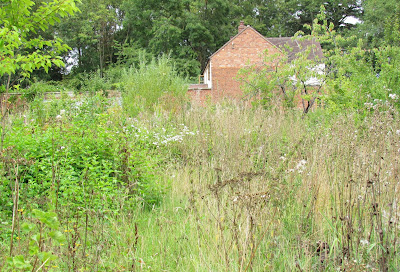I could have reused my last report's title as, once again, time has flown and it is nearly two weeks since we visited Berrington Hall.
This was our second outing to Berrington Hall and, not surprisingly, not much had changed! There were more campers using the camp site and some of the grass in their grasslands had been cut but overall the site was pretty much as I described it in my report of our earlier visit.
Therefore, I will not dwell on particulars other than to say that, for variety, we circuited their grounds in the opposite direction.
We started in the walled garden.
From here we passed the honey bee nest that was established in the wall
 |
| Photograph: David Williams |
We had our lunch here.
As you can see the sun was shining and it was very warm. Just as it had been for the past month or so.
But then a remarkable thing happened.
A large black cloud loomed.
We moved from the meadow to the vegetable garden.
Then a rare event took place.
It rained.
It was very wet rain and we had to find shelter.
After a few minutes under the trees which turned out to be no better than standing under an upturned colander, we made our way hurriedly to one of the polytunnels which was far more watertight.
The rain eased but everything was now wet making beating and sweeping a hazardous occupation. We were reduced to just looking for quite some time whilst the heat of the day caused some evaporation.
We made our way slowly from the vegetable garden, through the woodland, to the main grassland.
The sun had done its job and we were able to employ our usual tools again.
Right; that is the travel itinerary out of the way.
Now for the exciting bit.
What did we see?
A selection; in no particular order:
A tortoise beetle - Cassida rubignosa
Two hoverflies. The first was Myathropa florea, affectionately known as "Batman" due to the markings on its thorax.
 |
| Photograph: David Williams |
 |
| Photograph: David Williams |
 |
| Photograph: David Williams |
 |
| Photograph: David Williams |
 |
| Photograph: David Williams |
And the European cinchbug, an inhabitant of damp grassland:
 |
| Photograph: David Williams |
We finished the day by examining the magnificent tulip tree in front of the house.
We found an adult and juvenile Bordered shieldbug. Our initial attempts to identify the species were, quite frankly, abysmal. It was not until I looked at the adult under a microscope that I noted the border to its elytra.
 |
| Photograph: David Williams |
 |
| Photograph: David Williams |
My thanks to the residents of Berrington Hall for giving us permission to wander around their grounds doing what we enjoy doing and to David Williams for his excellent photographs.

































No comments:
Post a Comment
Please feel free to comment on this post...